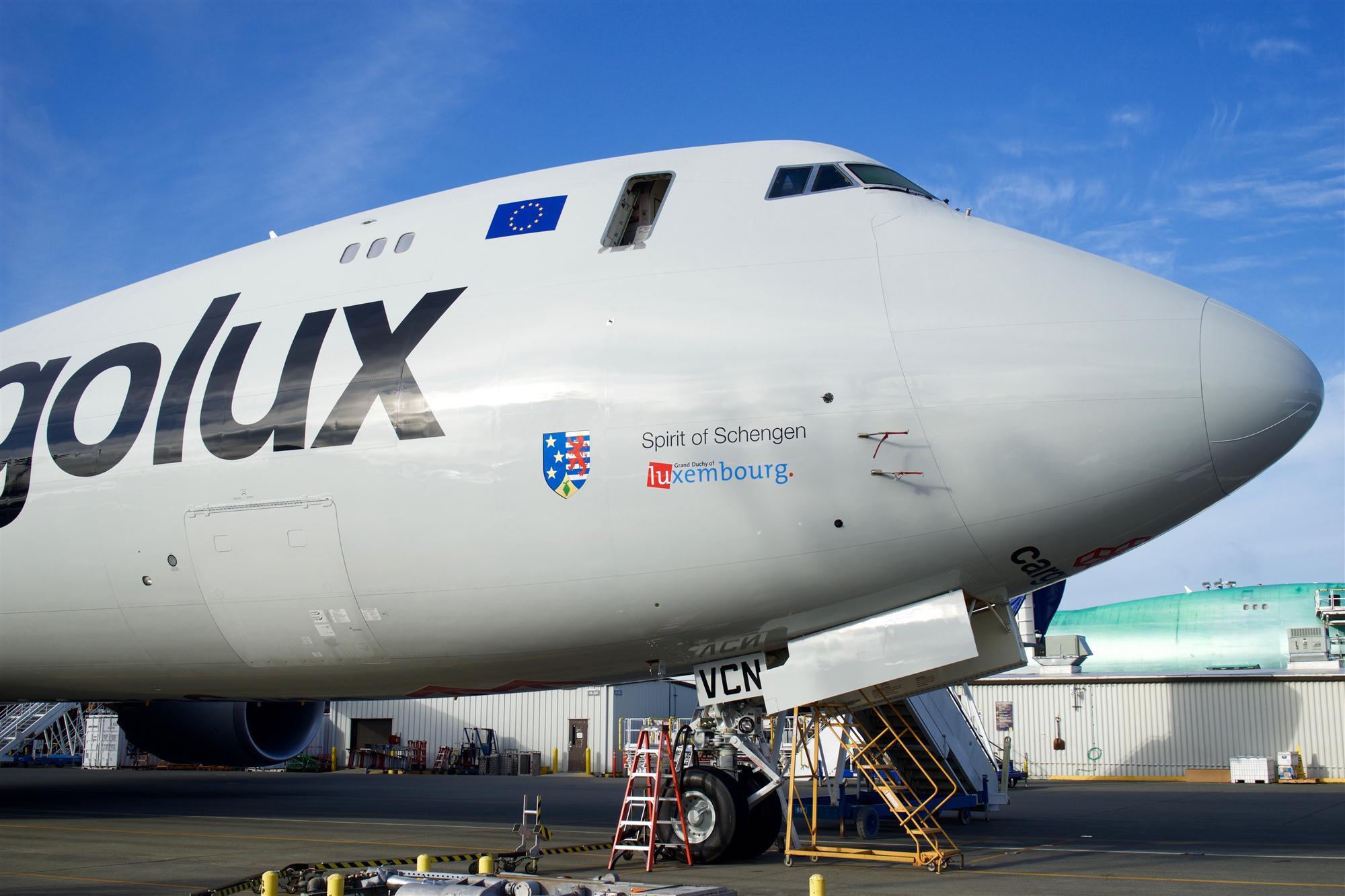The delivery of the 14th Boeing 747-8F to Cargolux has completed the firm order that the Luxembourg-based carrier had placed with the manufacturer.
The aircraft, registered LX-VCN and named Spirit of Schengen, is the 109th 747-8 and the 69th 747-8F to be delivered. The order for this frame was placed by Cargolux in February 2014.
“This is really the celebration of a partnership between the Boeing Company and Cargolux, and it’s a relationship that’s incredibly important to us,” said Monty Oliver, vice president of European sales at Boeing Commercial Airplanes, speaking at a ceremony at the Everett Delivery Centre [left in photo]. “Cargolux has been instrumental in the development of the 747-8F. Boeing is honoured to have a valued partner in Cargolux and to celebrate your 14th 747-8F aircraft.”

According to Cargolux, the aircraft was originally scheduled to be delivered in 2017, but the board of directors decided in August 2016 to work with Boeing to bring forward the delivery.
“The delivery schedule is a dynamic process,” said Onno Pietersma, executive vice president of maintenance and engineering at Cargolux [second from right in photo]. “Obviously we had to get the approval and the financing arranged, but there wasn’t a major difference. We based this on market demand and our good partnership with Boeing enabled us to do so, to make sure we had the right capacity at the right time.”
The 14th freighter arrives just as the carrier is ramping up towards the year-end peak season, during which airlines around the world have traditionally experienced additional air freight activity.
“We’ve seen some increase in demand for perishables from Latin America to Asia, such as flowers from Colombia to Japan and fruits to China,” said Pier Curci, the airline’s vice president of the Americas. “There’s a big push expected toward the end of the year, as we saw last year as well, where we did a tremendous amount of extra rotations of fruit charters from South America to China.”
Curci said that, from a general market perspective, he didn’t see much need to further expand Cargolux’s US network in the short term.
“A future opportunity could be some client-specific requests, but nothing immediate,” said Curci. “We have fairly decent coverage now, with multiple frequencies to all of the major points in the United States. We’ve enjoyed a lot of growth in the last four years, opening up additional operations including Dallas and Columbus, and expanding other points as well.”
The Cargolux group, which now has an all-747 fleet of 12 747-400Fs and 14 747-8Fs, was the launch customer for the 747-8F in 2005 with an order for 10, taking first delivery in October 2011.

With the Cargolux order now fulfilled, the only remaining -8Fs to be delivered at the time of writing are two for AirBridgeCargo, one for Korean Air Cargo, two for Nippon Cargo Airlines and one for Silk Way Airlines, as well as 15 for Volga-Dnepr Group that are due to be finalized with Boeing.
To match slowing demand, Boeing lowered the production rate of the 747-8 programme to 0.5 airplane per month in September 2016.
“We feel that that’s sustainable,” said Bruce Dickinson, vice president and general manager of the 747 and 767 programmes at Boeing Commercial Airplanes [left in photo]. “We don’t really want to go much lower than that, but I wouldn’t rule it out.”
Boeing remains confident that there is a market for large freighters, which it defines as those capable of carrying upwards of 80 tonnes. According to the manufacturer, there are about 520 of these in service today but many will be phased out in the coming years. Over the next 20 years, Boeing forecasts that 550 large freighters will be put into the market, including both new builds and conversions.
“747-400Fs will head out of service and start being replaced in earnest in about five or six years,” said Dickinson. “Conversions, which don’t have nose doors and are even less efficient, will come out of service sooner. The only airplanes left for the large cargo fleet right now are production -8Fs and 777Fs. We will be building a 777X freighter at some point, and Airbus may build the A350 freighter, but you can see that the likelihood is the 777 will not have a conversion, because it’s too expensive and those airplanes are getting so old that it’s not going to make a lot of sense.”
Dickinson said that he would prefer not to stay at six airplanes a year but in the meantime, the company is waiting for the replacement period to arrive. Although that has been delayed somewhat by the low fuel prices, Boeing is convinced that it will happen and that there are only two planes that can address the demand for large freighters – the 747-8F, which carries 137 tonnes, and the 777F, which carries 102 tonnes.
“We still have time,” he said. “That’s partly why we brought the production rate down. We’re confident we can fill that low rate. We have time, but we want to be careful. Imagine if you only had one large freighter, whether it be the 747-8F or the 777F. The question you have to ask yourself is: are you really going to support this huge of a market with just one big freighter? It doesn’t make sense, not to mention that different airlines have different needs.”
In particular, Boeing is very keenly interested in China and the expansion there. The growth from both Chinese and non-Chinese carriers means that there is a lot of optimism regarding cargo traffic into and out of the country, and, consequently, what that means for dedicated freighters.
“There’s been a lot of activity from our sales team there and that’s certainly an area of opportunity,” said. “When you consider the air traffic control limitations and the landing slots in the region, I think it could be positive for big freighters.”
By Jeffrey Lee
Asia Cargo News | Everett, Washington



